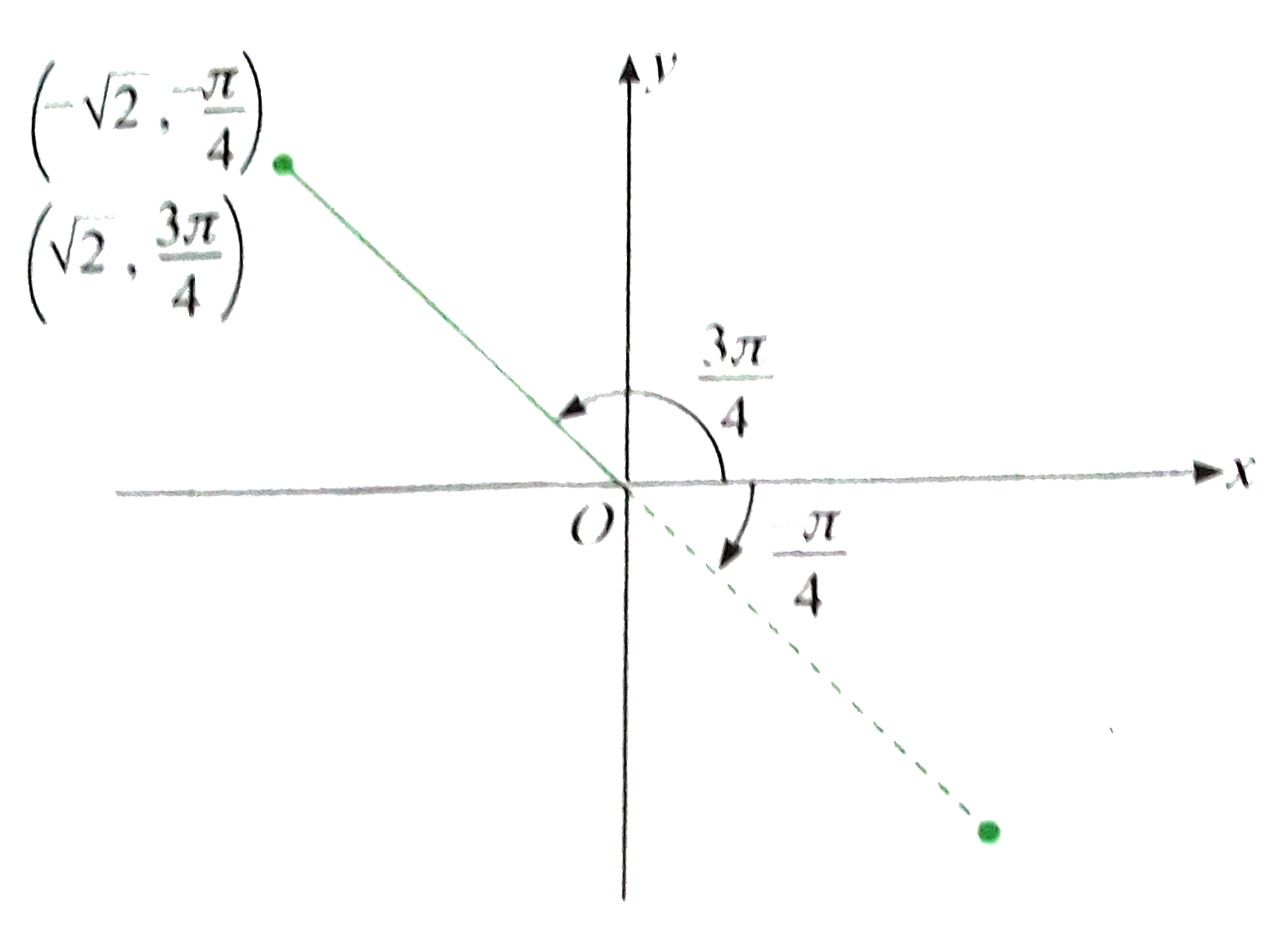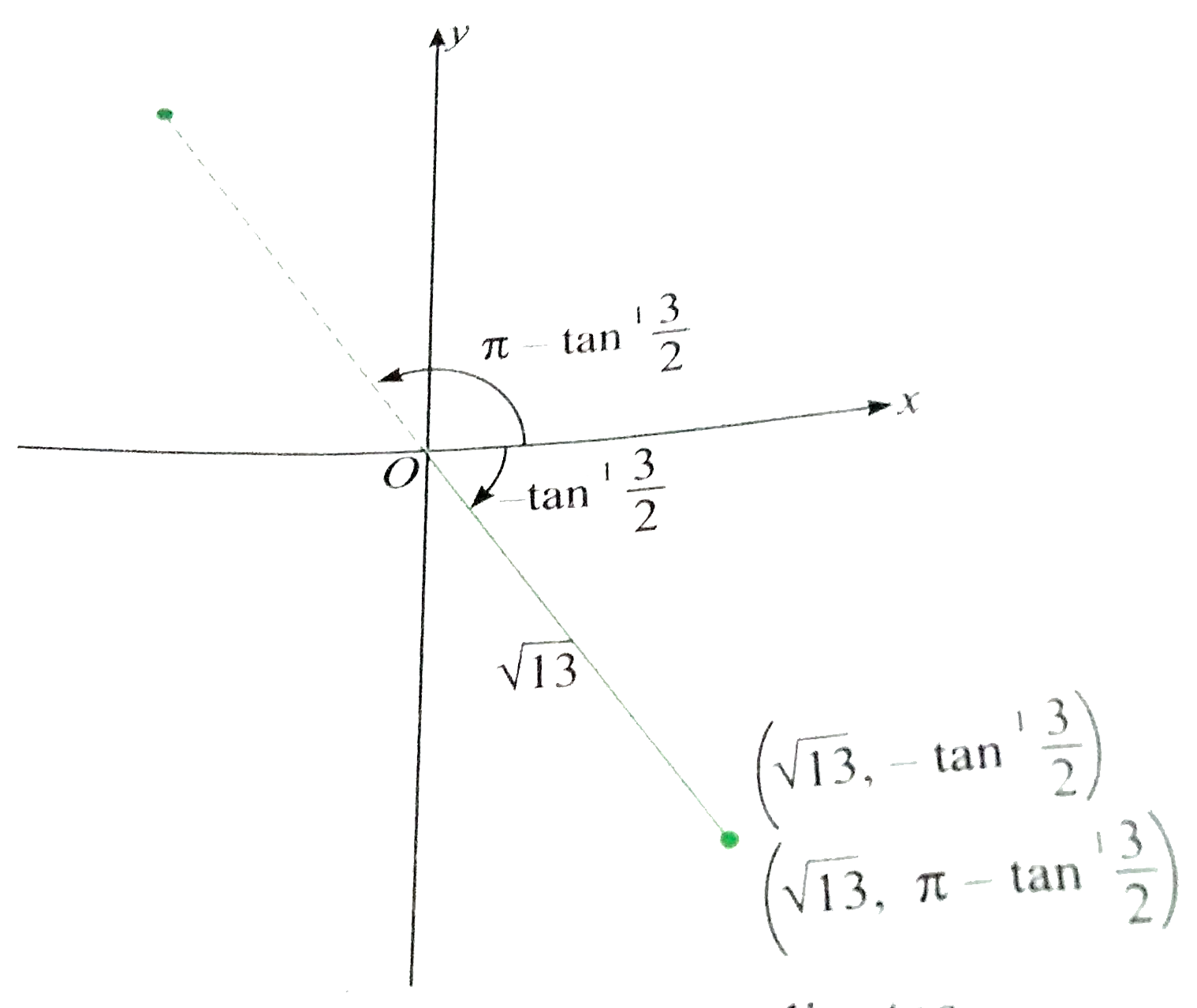Convert the following polar coordinates to its equivalent Cartesian coordinates.
(i) (2,π)
(ii) (√3,π/6) Solution in Tamil
(i) For the second quadrant point (x,y)≡(−1,1), we have
tanθ=yx=−1⇒θ=3π4

Using positive r, we have
r=√x2+y2=√(−1)2+(1)2=√2
So, one set of polar coordinates is (r,θ)≡(√2,3π/4)
Using negative r, we have coordinates =(−√2,−π/4)
(ii) For the fourth quadrant point (x,y)≡(2,−2), we have
tanθ=−32
⇒θ=tan−1(−32)=−tan−1^32
Using positive r, we have
r=√x2+y2=√(−3)2+(2)2=√13
So, one set of polar coordinates is
(r,θ)≡(√13,−tan−132)

Using negative r, we have coordinates
=(−√13,π−tan−132)
Topper's Solved these Questions
- BOOK - CENGAGECHAPTER - COORDINATE SYSYEM EXERCISE - Exercise 1.16videos
COORDINATE SYSYEM
- BOOK - CENGAGECHAPTER - COORDINATE SYSYEM EXERCISE - Exercise 1.28videos
COORDINATE SYSYEM
- BOOK - CENGAGECHAPTER - COORDINATE SYSTEMEXERCISE - Multiple Correct Answers Type2videos
COORDINATE SYSTEM
- BOOK - CENGAGECHAPTER - CROSS PRODUCTS EXERCISE - DPP 2.213videos
CROSS PRODUCTS
Similar Questions
What is the minimum area of a triangle with integral vertices ?
01:46View SolutionThe distance between the points (acosα,asinα) and (acosβ,asinβ) is
02:17View SolutionCoordinates of points on curve 5x2−6xy+5y2−4=0 which are nearest to origin are
01:07View SolutionLet →a and →b be two vectors of equal magnitude 5 units. Let →p,→q be vectors such that →p=→a−→b and →q=→a+→b. If |→p×→q|=2{λ−(→a.→b)2}12, then value of λ is
03:15View SolutionThe Cartesian coordinates of point having polar coordinates (-2,(2 pi)/(3)) will be
01:20View SolutionConvert the following points from polar coordinates to the corresponding Cartesian coordinates.
(i) (2,π/3)
(ii) (0.π/2)
(iii) (−√2,π/4)03:29View SolutionConvert the following polar coordinates to its equivalent Cartesian coordinates.
(i) (2,π)
(ii) (√3,π/6)01:19View SolutionConvert the following Cartesian coordinates to the cooresponding polar coordinates using positive r.
(i) (1,−1)
(ii) (−3,−4)04:27View SolutionFind the cartesian coordinates of the points whose polar coordinates are
(5√2,π4)02:41View SolutionConvert the following points from polar coordinates to the corresponding Cartesian coordinates.
(i) (2,π/3)
(ii) (0.π/2)
(iii) (−√2,π/4)02:08View SolutionConvert the polar coordinates to its equivalent Cartesian coordinates(2,π).
04:33View SolutionConvert the following Cartesian coordinates to the cooresponding polar coordinates using positive r.
(i) (1,−1)
(ii) (−3,−4)02:46View SolutionConvert the following polar coordinates to its equivalent Cartesian coordinates. (i) (2,π6) (ii) (2,11π6)
01:37View SolutionConvert the following polar coordinates to its equivalent Cartesian coordinates. (i) (2,pi) (ii) (sqrt(3),pi//6)
01:10View SolutionConvert the following Cartesian coordinates to the cooresponding polar coordinates using positive r. (i) (1,-1) (ii) (-3,-4)
01:18View SolutionFind the cartesian coordinates of the points whose polar coordinates are
(5√2,π4)01:28View Solution

